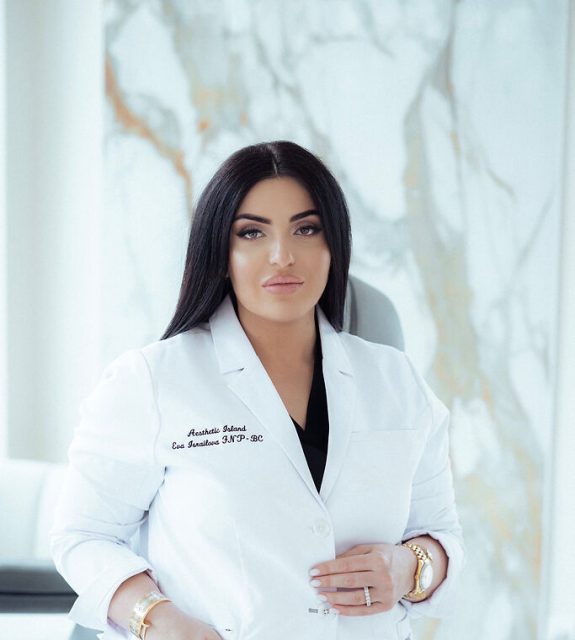Viraj J. Mehta, MD, MBA is an Oculofacial Plastics and Orbit expert, who serves a local and an international community at his practice near Washington, D.C. Born and raised in Cincinnati, OH, Dr. Mehta attended Cornell University for undergraduate and business school. He went on to complete his medical education and training at top institutions across the country, including Case Western Reserve University School of Medicine, Memorial Sloan Kettering Cancer Center, and Mayo Clinic. Dr. Mehta is excited to utilize his elite training to help patients look and feel their best! He operates his practice, Mehta Facial Plastics, in the Washington D.C. area.
Haute Beauty sat down with Dr. Viraj J. Mehta to talk about chemical peels.
 Photo Credit: Shutterstock
Photo Credit: Shutterstock
HB: What are chemical peels all about?
Let’s talk about an effective way to get that summer glow. Chemical Peels! Chemical peels can vary, but the ultimate goals are to remove the outer surface layers of blemished, dull, dead cells and to stimulate the growth of vibrant, rejuvenated skin. This a relatively easy, non-invasive in-office procedure with minimal downtime. As we spend more time indoors socially-distancing, and more time in video-conferences, chemical peels can offer facial rejuvenation more cost-effectively than lasers or surgery.
There are many different types of chemical peels that target various layers of the skin. The deeper the peel, the longer the recovery and higher risk, but ultimately better result.
Superficial Peels: Your most common superficial peel is with an Alpha-Hydroxy Acid (AHA). Many of these compounds have made their way into over-the-counter products because of their good safety profile. Glycolic acid is a common AHA that is combined with other medical-grade peels or found in many skin care products. Another superficial peel product is Salicylic Acid. These peels penetrate through the epidermis and lead to a very superficial sloughing of abnormal cells.
Medium Peels: Trichloroacetic Acid (TCA) in concentrations up to 30% is the most common medium depth peel. These peels penetrate deeper into the dermis to provide stronger effects.
Deep Peels: Deep chemical peels penetrate well in the layers of the dermis to stimulate even more shedding and sloughing of the outer skin layers. Deep peels include higher concentrations of TCA or Phenol.
HB: What can chemical peels work to address?
Chemical Peels can address the following:
- Fine lines and wrinkles
- Skin discoloration
- Acne and Acne Scarring
- Irregular, uneven Skin Tone
- Under-Eye Dark Circles
- Crow’s Feet around Eyes
- Dull Complexion
- Age Spots
- Sun Damage
HB: Walk us through the treatment.
Dr. Mehta’s office now carries the Perfect Derma Peel. This peel offers a mild to medium effect, often with noticeable results after just one treatment. The ease and relative safety of this product on all different skin types and tones make it a great peel for most people.
A consultation is first required to discuss your skin concerns and goals. If this peel is a good option, we can proceed with the treatment.
Step 1:
We have you clean your face with a gentle cleanser to remove make-up and oils.
Step 2:
We cleanse your face even more with some acetone to help remove any additional oil.
Step 3:
The peel is applied to your face. This process takes about 10-15 minutes. You will feel a little warmth and stinging at first, but then this resolves in a few seconds.
After applying the peel, the patient is free to go home. Dr. Mehta and his team provide a take-home care kit with detailed instructions. It is very important to not touch, wash, rub, or use make-up for at least 6-hours after the peel.
HB: Who is a good candidate?
Because this is a mild to moderate peel, the Perfect Derma Peel is relatively safe for any skin tone and for people with sensitive skin. Dr. Mehta will assess your skin to determine if might benefit from the peel. This product is also good for patients as young as 16 years old, especially to address acne concerns. Some patients with a history of sensitivity to any product in the peel, patients with a history of cold sores, or patients using Accutane may not be good candidates. There is always some risk with chemical peels, including burns and skin pigment changes, all of which Dr. Mehta will discuss with you prior to your treatment.
HB: What is the recovery like?
On Days 1 and 2 of the peel, the treated skin will feel tight and may appear a little darker. Beginning at least 6 hours after the application of the peel, you may apply a small amount of the included moisturizer. You can also wash your face with a gentle cleanser. It is important to avoid any excessive sweating, exercise, and sun exposure during this peeling process.
On Days 3-6, the peeling process begins. Continue using the provided moisturizer as your skin will feel itchy. It is very important not to rub, pick, or pull on the peeling skin as this can lead to scarring.
On Day 7 and beyond, the peeling process is essentially complete, and you’ll begin to see your new, softer, rejuvenated skin! Continue to apply the moisturizer throughout this process and be sure to use sunscreen. Dr. Mehta can help you create a simple skin regimen that will keep your skin hydrated and nourished! After 4weeks or so, another peel can be applied if needed.
 Photo Credit: Shutterstock
Photo Credit: Shutterstock
HB: What is the cost?
The cost of this peel with the take-home care kit can range from $300-$500 per treatment, often with some discounts when multiple treatments are purchased together.
Haute Beauty is affiliated with the luxury lifestyle publication Haute Living. As a section of Haute Living magazine, Haute Beauty covers the latest advancements in beauty and wellness, providing readers with expert advice on aesthetic and reconstructive treatments through its network of acclaimed surgeons.
To learn more about Haute Beauty, visit https://hauteliving.com/hautebeauty/























